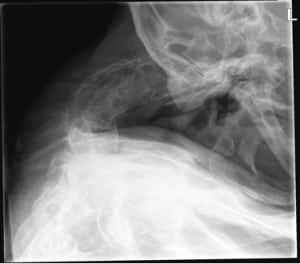| Author | Affiliation |
|---|---|
| Jim Kennedy, MCh | Department of Emergency Medicine, Mater Misericordiae Hospital, Dublin, Ireland |
| Noel Cassidy, MCh | Department of Emergency Medicine, Mater Misericordiae Hospital, Dublin, Ireland |
A 76-year-old man with a history of ankylosing spondylitis presented to the emergency department complaining of neck pain. He stated the pain began when he slipped to the ground from a seated position in his bedroom. On examination his head had adopted a posture so that his chin was resting on his right clavicle, he was noted to have reduced power and altered sensation in his lower limbs. A lateral radiograph of his cervical spine (Figure) shows an acute kyphosis with an associated fracture of the lower cervical vertebra. The vertebras above and below the fracture are rigidly ankylosed.
He was treated with open reduction and internal fixation after a period in halo traction. Unfortunately there was no recovery in neurological function.
This image demonstrates that catastrophic spinal injuries can occur with low energy trauma in patients ankylosing spondylitis because the fused segments act as force amplifying levers. These patients should be accorded extra consideration prior to ruling out a fracture.
Footnotes
Supervising Section Editor: Sean O. Henderson, MD
Submission history: Submitted October 3, 2012; Accepted October 22, 2012
Full text available through open access at http://escholarship.org/uc/uciem_westjem
DOI: 10.5811/westjem.2012.10.13903
Address for Correspondence: Jim Kennedy, MCh, Mater Misericordiae University Hospital, Eccles St., Dublin 7. Email:getjimkennedy@gmail.com.
Conflicts of Interest: By the WestJEM article submission agreement, all authors are required to disclose all affiliations, funding sources and financial or management relationships that could be perceived as potential sources of bias. The authors disclosed none.



